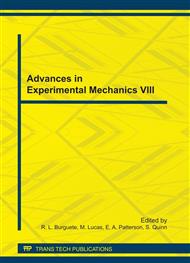p.315
p.321
p.327
p.333
p.339
p.345
p.351
p.357
p.363
A Strategy for Delivering High Torsionality in Longitudinal-Torsional Ultrasonic Devices
Abstract:
A composite longitudinal-torsional vibration mode has applications in ultrasonic motors, ultrasonic welding and ultrasonic drilling. There are two ways to obtain this vibration behaviour using a single transducer, namely (i) coupling of a longitudinal and a torsional mode, which is known to be difficult; and (ii) degenerating a longitudinal mode to deliver longitudinal-torsional behaviour at the horn tip. A mode-degenerating horn is achieved by incorporating helical or diagonal slits in an otherwise traditional exponential horn driven by a Langevin transducer. However, it is often difficult with this configuration to avoid coupling of unwanted bending modes, low responsiveness, and loss of ultrasonic energy due to boundaries between tuned components. Therefore, in this study the mode-degenerating characteristics are achieved by incorporating the helical slits and exponential geometry features in the front mass of the transducer itself. Finite element analysis and vibration experimental analysis show that this strategy prevents coupling of bending modes, increases responsiveness, and reduces energy losses. Most importantly the transducer delivers a very high torsionality.
Info:
Periodical:
Pages:
339-344
Citation:
Online since:
August 2011
Authors:
Price:
Сopyright:
© 2011 Trans Tech Publications Ltd. All Rights Reserved
Share:
Citation:


